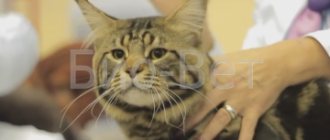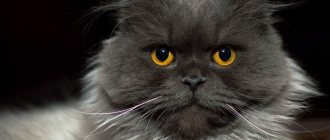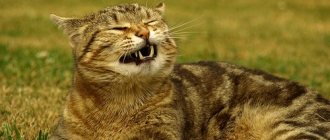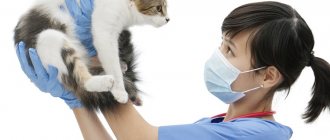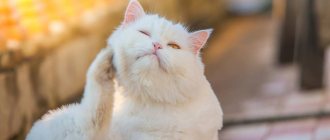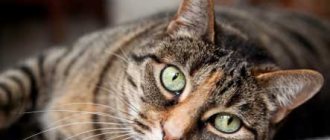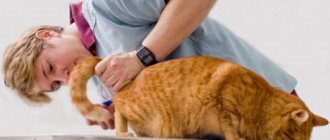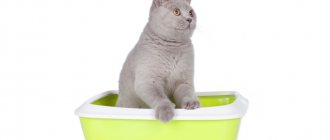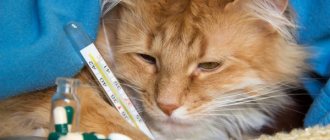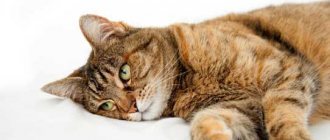When choosing a pet, most people look for a healthy and attractive animal. But there are exceptions when, behind the superficial imperfections, some people see the zest in a pet and would not exchange their friend for anyone.
Cats with slanted eyes look unusual and cute, but a good owner always thinks whether this is dangerous for their health and why the animal acquires such a defect.
Strabismus in kittens
In veterinary practice, the incorrect location of the eyeball in a cat in the orbit of one or both eyes, when the visual axes do not intersect at one point, is called strabismus. Converging pupils at the nose are called esotropia, and diverging pupils in different directions are called exotropia.
In kittens, this phenomenon occurs most often, because... due to weak eye muscles, the pupil may look in one direction or the other, but there is nothing wrong with that. Typically, early strabismus in an animal goes away after 5-6 months.
But sometimes it happens that the cat’s strabismus remains with it even after a long time. In this case, you need to visit a veterinarian to determine the cause.
If the matter is a genetic predisposition, then there is nothing to be afraid of, the cat will be able to live with this feature. And if your pet develops strabismus as an adult, this is a cause for concern.
Acquired strabismus can be a consequence of diseases such as:
- viral infections;
- diseases of the nervous system;
- benign and malignant tumors;
- disorders in the vestibular apparatus;
- consequences of injuries.
The veterinarian must determine the cause of strabismus and, if it was acquired as a result of illness or injury, begin treatment in a timely manner. In such cases, strabismus is only a consequence of a disease that can lead to serious problems with the pet’s health.
Most often, strabismus is inherited by a cat from its ancestors.
Signs and types of strabismus
Strabismus in cats can be unilateral, when only one eyeball deviates from its normal position, or bilateral, when the disorder extends to both eyes. The eyeballs are mobile, and their joint movement in the orbits is ensured by several small muscles. If, for some reason, the coordinated work of these muscles is disrupted, or the eyeball is displaced relative to its correct position within the orbit, then strabismus occurs.
In many cases the problem can be determined visually , but this is not always possible. If the cat's eyes are oriented differently, the pupils and corneas are asymmetrically located, these obvious signs will indicate strabismus. If the asymmetry is not too obvious or not noticeable at all, you can observe the cat. If, while looking at an object, her two eyes fixate on it differently, she probably has strabismus.
In some cases, strabismus is not accompanied by a clear turn of the eyeball in any direction, while the pupil may have the usual round shape, and the eye is no different in appearance from a healthy one. To check your suspicions and, if necessary, begin treatment, the cat owner needs to contact a specialist.
If the cat's pupils are close to the nose, which is often found in cats of Siamese or Oriental breeds, then this type of strabismus is called convergent. If, on the contrary, the pupils are deviated from the nose in different directions, then the observed strabismus is called divergent. Convergent strabismus is more common and is often congenital. Strabismus that occurs in an initially healthy cat is acquired and can be caused by many different factors.
Cat Breeds Prone to Strabismus
Cats of any breed can have strabismus, but there are animals among which it is most common:
- Siamese;
- Thai;
- snow-shoe;
- Balinese;
- Javanese.
Cross-eyed Siamese cat
This phenomenon is associated with a special gene called “acromelanism”. It is he who gives cats an unusual color of fur and eyes (dark paws and tail, light body and bright blue eyes). But this gene gives cats not only beauty, because of it the optic nerve develops incorrectly, the cat sees everything in double form, and objects look flat. Attempts to put it all together and take a better look lead to the pet acquiring slanted eyes, sometimes the pupils move from side to side.
Is correction required?
Hereditary strabismus is only an external feature that does not cause any inconvenience to the cat and does not harm it.
It’s another matter if strabismus was acquired in adulthood, then immediate help from a specialist is needed. To accurately diagnose problems with the nervous system and vestibular system, an MRI of the eye orbits or brain may be required.
For various inflammatory diseases, drug treatment is necessary, which is prescribed by a veterinarian. With proper and timely therapy, strabismus in your cat will be completely cured.
If the problem of strabismus is associated with various injuries or damage to the eye muscles, then there is only one way out of the situation - surgical intervention. The operation will have a good outcome only if the disease is detected at an early stage. Otherwise, the animal will face unpleasant consequences for its health and well-being.
That is why it is so important to promptly contact a veterinary clinic as soon as the disease is identified.
Reasons for appearance
If this is an acquired phenomenon, then you need to consider the main factors that can lead to a cat getting sick:
- presence of injury that may occur from a fall from a height. A severe blow to the head may also be present. The cat's eyes suffer mechanical damage, or the functioning of the optic nerve is disrupted. In this case, any type of disease may occur;
- heredity, which is determined by genes. If the deviation is within the acceptable norm, then treatment is not required. Cats from birth get used to this pathology and feel great in the future;
- problems with the vestibular apparatus. It causes a distorted perception of the information received by the brain, in particular, the position of the head in space is incorrectly perceived;
- various diseases of the nervous system. The interaction between the eyes and the central nervous system is disrupted. This case also includes brain tumors of various etiologies;
- rabies, in which the pupil dilates greatly and clouding of the cornea is observed;
- otitis media of both the inner and middle ear;
- the presence of dropsy in the brain - hydrocephalus;
- feline leukemia;
- glaucoma;
- encephalitis;
- meningitis.
INTERESTING TO FIND OUT: A cat’s kidneys are failing - what to do?
Mister Cat talks: famous cross-eyed cats
Due to the fact that cats with strabismus look touching and special, their owners do not miss the opportunity to show everyone around their special pet.
For example, the popular cat Spangles from South Carolina. His squint does not in the least prevent him from living life to the fullest, having fun and posing for the camera in various outfits.
Spangles
Spangles
Spangles
Spangles
Spangles
And here is a ginger cat from California named Jarvis. He was found by his current owners on the street at 4 weeks of age. Apparently, the previous owner, having noticed a flaw in the kitten in the form of slanted eyes, decided to get rid of it in this way. The cat was picked up by a local resident and at first wanted to give him to a shelter, but then she changed her mind and kept the baby with her.
Jarvis
Jarvis
Cat Jarvis gained fame and was loved by millions of people when his owner posted his photos on the Internet. People couldn't ignore such a charming and funny ginger cat. And Jarvis’s owner herself says that the cat has been incredibly smart, active and cheerful since childhood, and she is very glad that she did not give him to a shelter.
Jarvis
Jarvis 1111
